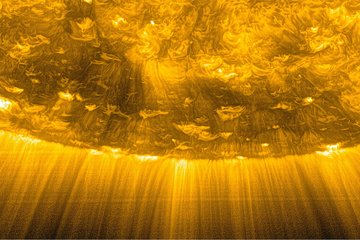All genres
1.
Journal Article
Observations of solar X-ray and EUV jets and their related phenomena. Astron. Nachrichten 337, pp. 1024 - 1032 (2016)
2.
Journal Article
Analysis of UV and EUV emission from impacts on the Sun after 2011 June 7 eruptive flare. Astronomy and Astrophysics 592, A17 (2016)
3.
Journal Article
Magnetic reconnection between a solar filament and nearby coronal loops. Nature Physics 12 (9), pp. 847 - 851 (2016)
4.
Journal Article
Observations of EUV waves in 3He-rich solar energetic particle events. Astrophysical Journal 812 (1), 53 (2015)
5.
Journal Article
IRIS Si IV Line Profiles: An Indication for the Plasmoid Instability During Small-scale Magnetic Reconnection on the Sun. Astrophysical Journal 813, pp. 86 - 96 (2015)
6.
Journal Article
Rayleigh-Taylor Type Instabilities in the Reconnection Exhaust Jet as a Mechanism for Supra-Arcade Downflows in the Sun. Astrophysical Journal 796 (2), L29 (2014)
7.
Journal Article
Observations of Supra-Arcade Fans: Instabilities at the Head of Reconnection Jets. Astrophysical Journal 796 (1), 27 (2014)
8.
Talk
Observations of flare supra-arcades. 40th COSPAR Scientific Assembly, Moscow, Russia (2014)
9.
Poster
Observations of a blast EUV wave in 3He-rich solar energetic particle sources. 14th Annual International Astrophysics Conference, Tampa, USA (2015)










